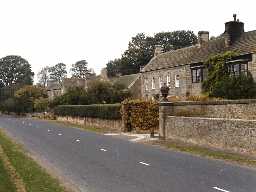Local History
Whalton (Northumberland)
Whalton is a small parish in central Northumberland. Its main settlement is the pretty village of Whalton. There is a wide variety of archaeological remains surviving both as earthworks and cropmarks as well as a fine range of buildings in the farms, hamlets and villages of the parish.
An Iron Age hillfort on Camp Hill is the oldest settlement site in the parish. Life probably changed very little in the Roman period, the only difference seemingly in the shape of enclosures as they become squarer in Roman times. Many enclosures seen on aerial photographs as cropmarks may date to this time, such as Shilvington Bridge, Dead Men's Graves, Well House and Windyside Plantation.
What Whalton was like in the early medieval period is unknown. However, the place-name element 'ing is thought indicative of Anglo-Saxon settlement, as in the names Riplington and Shilvington.
Medieval remains are more widespread. There were villages at Ogle, Shilvington, Twizell and Riplington. The incursion of Scottish raiders meant that fortifications were needed; indeed one of the highest points in the parish is called Watch Hill and hints at the vigilance needed at this time. Towers were built at The Old Rectory in Whalton, at Kirkley, and at Ogle where the Ogle family built Ogle Castle. The strength of religion was strong in the medieval period and the Ogles sponsored alterations to the Church of St Mary Magdalene as the main parish church, and a further possible chapel at Ogle itself.
The conflicts did not cease with the Union of the Crowns in the post-medieval period. Indeed, Henry Cavendish (a descendent of the Ogles) was a fierce supporter of the Royalist cause in the English Civil War. This period saw the modification of Ogle Castle to imitate the popular French styles of building, complete with moats, though much has since been lost.
In post-medieval times many villages shrank or became deserted altogether, such as Twizell. Earthworks survive to show the layout of house platforms, field systems and roadways at Shilvington as well as a [cock pit]. Apart from developments in agriculture in the 18th and 19th centuries and some fine new farm buildings, little changed in the parish. One of the few industries in the parish were Belsay Tilery and Whalton Mill.
A the beginning of the 20th century, Edwin Lutyens carried out work at Whalton Manor House. However, the tranquillity of Whalton parish did not escape World War II (1939-1945), when Tranwell Airfield was built.
An Iron Age hillfort on Camp Hill is the oldest settlement site in the parish. Life probably changed very little in the Roman period, the only difference seemingly in the shape of enclosures as they become squarer in Roman times. Many enclosures seen on aerial photographs as cropmarks may date to this time, such as Shilvington Bridge, Dead Men's Graves, Well House and Windyside Plantation.
What Whalton was like in the early medieval period is unknown. However, the place-name element 'ing is thought indicative of Anglo-Saxon settlement, as in the names Riplington and Shilvington.
Medieval remains are more widespread. There were villages at Ogle, Shilvington, Twizell and Riplington. The incursion of Scottish raiders meant that fortifications were needed; indeed one of the highest points in the parish is called Watch Hill and hints at the vigilance needed at this time. Towers were built at The Old Rectory in Whalton, at Kirkley, and at Ogle where the Ogle family built Ogle Castle. The strength of religion was strong in the medieval period and the Ogles sponsored alterations to the Church of St Mary Magdalene as the main parish church, and a further possible chapel at Ogle itself.
The conflicts did not cease with the Union of the Crowns in the post-medieval period. Indeed, Henry Cavendish (a descendent of the Ogles) was a fierce supporter of the Royalist cause in the English Civil War. This period saw the modification of Ogle Castle to imitate the popular French styles of building, complete with moats, though much has since been lost.
In post-medieval times many villages shrank or became deserted altogether, such as Twizell. Earthworks survive to show the layout of house platforms, field systems and roadways at Shilvington as well as a [cock pit]. Apart from developments in agriculture in the 18th and 19th centuries and some fine new farm buildings, little changed in the parish. One of the few industries in the parish were Belsay Tilery and Whalton Mill.
A the beginning of the 20th century, Edwin Lutyens carried out work at Whalton Manor House. However, the tranquillity of Whalton parish did not escape World War II (1939-1945), when Tranwell Airfield was built.
N13807
UNCERTAIN
Disclaimer -
Please note that this information has been compiled from a number of different sources. Durham County Council and Northumberland County Council can accept no responsibility for any inaccuracy contained therein. If you wish to use/copy any of the images, please ensure that you read the Copyright information provided.
